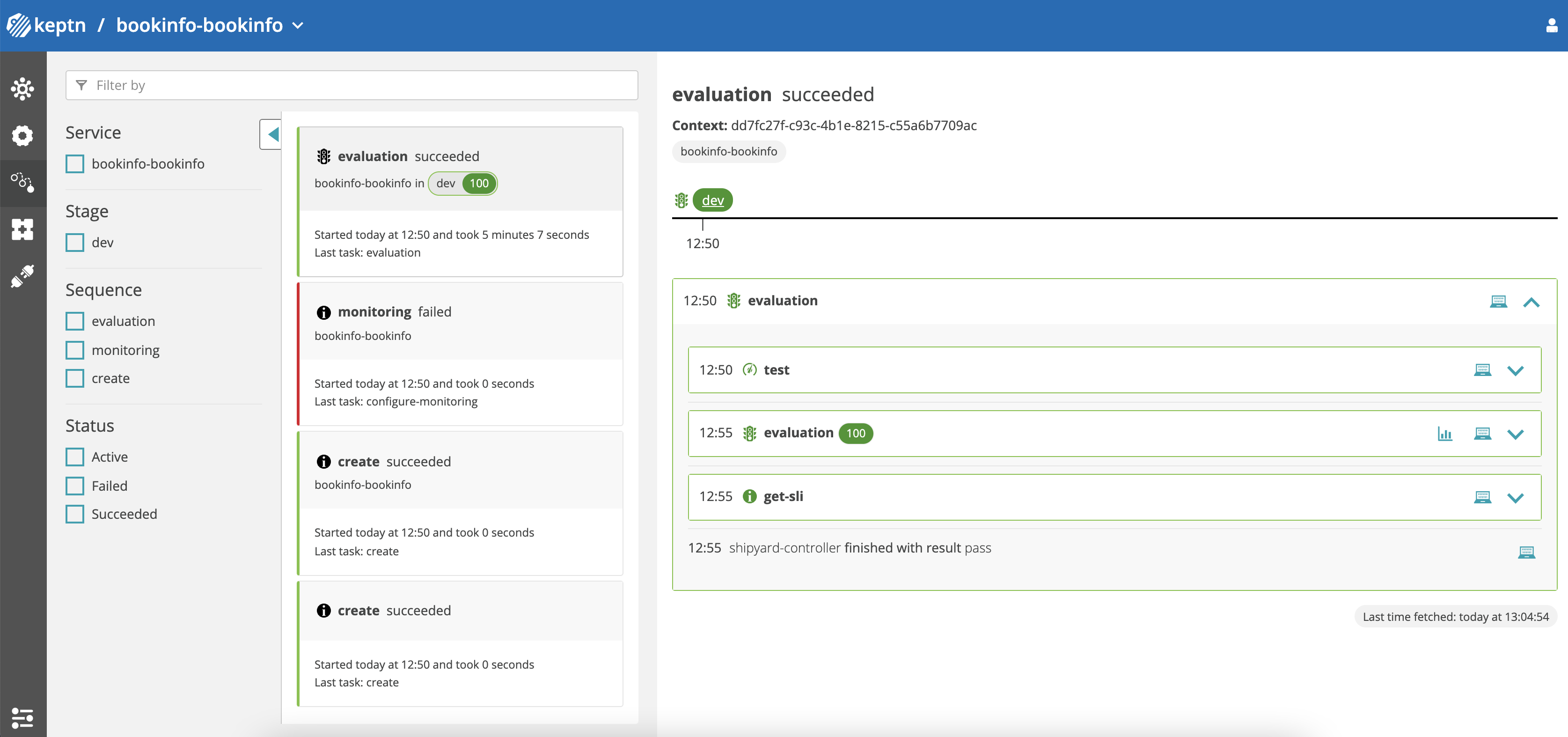Examples
Prerequisites
1. Bookinfo without Quality Gates
In this example we deploy an application group consisting of two demo applications,
Orkestra Helm Chart without Keptn
From the root directory of the repository, run:
helm upgrade --install orkestra chart/orkestra -n orkestra --create-namespace
Install the ApplicationGroup:
kubectl apply -f examples/simple/bookinfo.yaml
applicationgroup.orkestra.azure.microsoft.com/bookinfo created
The orkestra controller logs should look as follows on success,
orkestra-885c5ff4-kh7n9 orkestra 2021-03-23T07:53:24.452Z INFO setup starting manager
orkestra-885c5ff4-kh7n9 orkestra 2021-03-23T07:53:24.453Z INFO controller-runtime.manager starting metrics server {"path": "/metrics"}
orkestra-885c5ff4-kh7n9 orkestra 2021-03-23T07:53:24.453Z INFO controller-runtime.controller Starting EventSource {"controller": "applicationgroup", "source": "kind source: /, Kind="}
orkestra-885c5ff4-kh7n9 orkestra 2021-03-23T07:53:24.554Z INFO controller-runtime.controller Starting Controller {"controller": "applicationgroup"}
orkestra-885c5ff4-kh7n9 orkestra 2021-03-23T07:53:24.554Z INFO controller-runtime.controller Starting workers {"controller": "applicationgroup", "worker count": 1}
... truncated for brevity ...
orkestra-885c5ff4-kh7n9 orkestra 2021-03-23T08:04:18.875Z DEBUG controllers.ApplicationGroup workflow ran to completion and succeeded {"appgroup": "bookinfo"}
orkestra-885c5ff4-kh7n9 orkestra 2021-03-23T08:04:18.901Z DEBUG controller-runtime.controller Successfully Reconciled {"controller": "applicationgroup", "request": "/bookinfo"}
orkestra-885c5ff4-kh7n9 orkestra 2021-03-23T08:04:18.902Z DEBUG controller-runtime.manager.events Normal {"object": {"kind":"ApplicationGroup","name":"bookinfo","uid":"52c5095e-0aa1-4067-a434-f1155ebbbdcd","apiVersion":"orkestra.azure.microsoft.com/v1alpha1","resourceVersion":"30145"}, "reason": "ReconcileSuccess", "message": "Successfully reconciled ApplicationGroup bookinfo"}

Verify that the Application helm release have been successfully deployed
helm ls
NAME NAMESPACE REVISION UPDATED STATUS CHART APP VERSION
orkestra orkestra 1 2021-03-23 08:02:15.0044864 +0000 UTC deployed orkestra-0.1.0 0.1.0
ambassador ambassador 1 2021-03-23 08:02:35.0044864 +0000 UTC deployed ambassador-6.6.0 1.12.1
bookinfo bookinfo 1 2021-03-23 08:04:08.6088786 +0000 UTC deployed bookinfo-v1 0.16.2
details bookinfo 1 2021-03-23 08:03:26.1043919 +0000 UTC deployed details-v1 1.16.2
productpage bookinfo 1 2021-03-23 08:03:47.4150589 +0000 UTC deployed productpage-v1 1.16.2
ratings bookinfo 1 2021-03-23 08:03:25.9770024 +0000 UTC deployed ratings-v1 1.16.2
reviews bookinfo 1 2021-03-23 08:03:36.9634599 +0000 UTC deployed reviews-v1 1.16.2
Send request to productpage via Ambassador gateway/proxy
kubectl -n default exec curl -- curl -ksS https://ambassador.ambassador:443/bookinfo/ | grep -o "<title>.*</title>"
<title>Simple Bookstore App</title>
2. Bookinfo with Quality Gates
Prequisites
- A Kubernetes cluster with sufficient resources to run the Keptn Controller
⚠️ Avoid using a cluster with a low number of nodes and low CPU/RAM or a KinD, Minikube or microk8s cluster
In this example we will show how to use Keptn to perform a promotion based on the evaluation of a Quality Gate.
The Application Group deploys an application that relies on multiple supporting layers to be deployed and running before the application can be started. The bookinfo application relies on the following layers:
- Istio CRDs - This layer (istio-base) contains the Istio CRDs that are used to configure the Istio service mesh.
- Prometheus - This layer contains the Prometheus component that is used to monitor the application and leveraged by Keptn to perform the evaluation of the Quality Gate.
- Istio - This layer (*istiod) )contains the Istio service mesh that is used to deploy the application.
- Istio Ingress Gateway - This layer contains the Istio Ingress Gateway that is used to expose the application.
- Bookinfo - This layer contains the bookinfo application.
The scenarios that we will use in this example are:
The bookinfo application is deployed with the Istio sidecar injection enabled. The application is configured to use the Keptn executor to perform evaluation of the Quality Gate.

- The productpage sidecar is configured to serve traffic without any issues. We expect the
Workflowand subsequently theApplicationGroupto succeed.
Keptn dashboard - Success
⚠️ monitoring failed is a known, benign issue when submitting the
ApplicationGroupmultiple times. Authenticate with Keptn Controller for the dashboard:
export KEPTN_ENDPOINT=http://$(kubectl get svc api-gateway-nginx -n orkestra -ojsonpath='{.status.loadBalancer.ingress[0].ip}')/api \
export KEPTN_ENDPOINT=http://$(kubectl get svc api-gateway-nginx -n orkestra -ojsonpath='{.status.loadBalancer.ingress[0].ip}')/api \
keptn auth --endpoint=$KEPTN_ENDPOINT --api-token=$KEPTN_API_TOKEN
Retrieve the dashboard URL, Username and Password:
The IPs and password will differ for each cluster.
keptn configure bridge --output
Your Keptn Bridge is available under: http://20.75.119.32/bridge
These are your credentials
user: keptn
password: UxUqN6XvWMpsrLqp6BeL

- The productpage sidecar is configured to inject faults (return status code 500, 80% of the time) using the
VirtualService. We expect theWorkflowand subsequently theApplicationGroupto fail & rollback to the previousApplicationGroupspec (i.e. Scenario 1).
Keptn dashboard - Failure

Installation
Orkestra Helm Chart
From the root directory of the repository, run:
helm upgrade --install orkestra chart/orkestra -n orkestra --create-namespace --set=keptn.enabled=true --set=keptn-addons.enabled=true
💡 Note: If prometheus is expected to run in a different namespace the user must specify the namespace in the
--setoption as follows,export PROM_NS=prometheus helm upgrade --install orkestra chart/orkestra -n orkestra --create-namespace --set=keptn.enabled=true --set=keptn-addons.enabled=true --set=keptn-addons.prometheus.namespace=$PROM_NS
Scenario 1 : Successful Reconciliation
The bookinfo application is deployed using the following Kubernetes manifests:
The ConfigMap is used to configure the Keptn executor and contains the following:
- keptn-config.yaml - This file contains the Keptn configuration.
- sli.yaml - This file contains the SLI configuration.
- slo.yaml - This file contains the SLO configuration.
- config.yaml - This file contains the configuration for the
heyload generator.
kubectl create -f examples/keptn/bookinfo.yaml -n orkestra \
kubectl create -f examples/keptn/bookinfo-keptn-cm.yaml -n orkestra
Scenario 2 : Failed Reconciliation leading to Rollback
kubectl apply -f examples/keptn/bookinfo-with-faults.yaml -n orkestra
Cleanup
- Delete the bookinfo
ApplicationGroupand wait for the reverse workflow to complete
kubectl delete -f examples/keptn/bookinfo.yaml -n orkestra
- Once the
ApplicationGroupis deleted, delete the Keptn configuration configMap
⚠️ Deleting the Keptn ConfigMap before the
ApplicationGroupwill cause the reverseWorkflowto fail causing cleanup to fail.
kubectl delete -f examples/keptn/bookinfo-keptn-cm.yaml -n orkestra
Manual Testing
Trigger evaluation
keptn create project bookinfo --shipyard=./shipyard.yaml
keptn create service bookinfo --project=bookinfo
keptn configure monitoring prometheus --project=bookinfo --service=bookinfo
keptn add-resource --project=bookinfo --service=bookinfo --resource=slo.yaml --resourceUri=slo.yaml --stage=dev
keptn add-resource --project=bookinfo --service=bookinfo --resource=prometheus/sli.yaml --resourceUri=prometheus/sli.yaml --stage=dev
keptn add-resource --project=bookinfo --service=bookinfo --resource=job/config.yaml --resourceUri=job/config.yaml --stage=dev
keptn trigger evaluation --project=bookinfo --service=bookinfo --timeframe=5m --stage dev --start $(date -u +"%Y-%m-%dT%T")